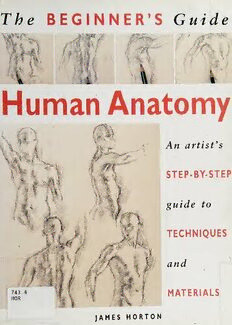
The Beginners Guide, Human Anatomy PDF
Preview The Beginners Guide, Human Anatomy
Human Anatomy An artist’s STEP-BY-STEP guide to TECHNIQUES i and * MATERIALS JAMES HORTON Digitized by the Internet Archive in 2019 with funding from Kahle/Austin Foundation https://archive.org/details/humananatomyartiOOOOhort SLE PUBLIC LIBRARY 3 9 00 311 5 The Beginner’s Guide Human Anatomy An artist’s step-by-step guide to techniques and materials JUN l § LISLE LIBRARY DISTRICT LISLE, ILLINOIS 60532 TEL: (630) 971-1675 DtMCO m ■ . i shix.x'Ts.h The Beginner's Guide Human An artist's step-by-step guide to techniques and materials :-v '■ S^RgSpB^. .v /’V'V'te^ First published in 2002 by New Holland Publishers (UK) Ltd London • Cape Town • Sydney • Auckland Garfield House, 86-88 Edgware Road London W2 2EA United Kingdom www.newhollandpublishers.com 80 McKenzie Street Cape Town 8001 South Africa Level 1, Unit 4,14 Aquatic Drive Frenchs Forest, NSW 2086 Australia 218 Lake Road Northcote, Auckland New Zealand Copyright © 2002 New Holland Publishers (UK) Ltd All rights reserved. No part of this publication may be reproduced, stored in a retrieval system, or transmitted in any form or by any means, electronic, mechanical, photocopying, recording or otherwise, without the prior written permission of the publishers and copyright holders. 3579 10 8642 ISBN 1 84330 057 5 Designed and edited by Axis Design Editions Limited 8 Accommodation Road London NW11 8ED Art Director: Sian Keogh Managing Editor: Michael Spilling Art Editor: Juliet Brown Photographer: David Jordan Senior Editor: Clare Hubbard Production: Hazel Kirkman Reproduced in Singapore by Pica Digital PTE Ltd Printed and Bound in Malaysia by Times Offset (M) Sdn Bhd Acknowledgements Special thanks are due to Daler-Rowney, PO. Box 10, Bracknell, Berkshire, RG12 4ST for providing the materials and equipment featured in this book. LISLE LIBRARY If C* "■*> n ^, LISLE, ILUNOiS Contents Introduction 6 10 Materials and Equipment How the Body Works 16 24 Gallery Projects 1 30 ARMS 2 34 TORSO AND LEGS 3 42 HEADS 4 46 MALE AND FEMALE 52 5 MALE TORSO 58 6 FEMALE RECLINING 7 66 ATHLETE 72 8 DANCER 80 Index Introduction T he human figure has been an important part of world art since the first prehis¬ toric attempts to create images. At the zenith of their cultural and artistic achievements, the Ancient Greeks (7th-5th century bc) made great advances in the depiction of the human form. Sculpture was then the most important medium, and those carvings and bronzes that have survived demonstrate the Greeks' great skill. Among the works of Pheidias, who lived in the 5th century bc, are the two great sculp¬ tures of Athene and Zeus in Olympia. Pheidias's work demonstrates the Greeks' understanding of how the human body worked - and how it should be represented. We can recognize similar contemporary criteria for the perfect muscular male form Arms Studies also esteemed in Ancient Greece. However, Michelangelo Buonarroti (1475-1564) the criteria for the female form has differed throughout history, and is certainly different Michelangelo's many anatomical studies gave now compared to when the Greeks created him an excellent eye for the human form. Venus de Milo their works of art. The Venus de Milo for Greek, 1st century bc example - a lst-century bc Greek statue dis¬ covered on the island of Melos in 1820 - This famous statue, which resides in the Louvre shows that the ideal woman of that time Museum in Paris, is an example of the advanced was of a fuller build than is idealized in anatomical knowledge of the Ancient Greeks. our modern society. 7 Introduction In the Rome of antiquity (750 bc-ad 500), very little in artistic terms; but by the time athletes, warriors, soldiers and gladiators the Renaissance was in its stride, the human were all at the heart of Roman culture and form was once again at the centre of high art. there are many sculptures from Roman times As always, religion was providing an outlet that bear witness to the importance of physi¬ for the depiction of the human form and cal perfection. although the worship of a Christian God was The long period between the end of the based more on the spiritual than the Roman empire and the start of the Italian physical, Christ was in the main portrayed as Renaissance in the 14th century produced a well-built man. Indeed, most characters portrayed in Renaissance paintings are Valpincon Bather shown with well-nourished bodies. Jean Auguste Dominique Ingres (1780-1867) It was at this time that there began a more scientific inquiry into the workings of the Ingres used his knowledge of anatomy to achieve human body, which extended into the dissec¬ near-perfection in his paintings of nudes. tion of corpses. Michelangelo (1475-1564), for example, risked a death sentence when he secretly dissected a human body by candlelight, in order to extend his anatomical knowledge. Interfering with dead people was illegal at that time - even if the purpose was a search for knowledge. Leonardo da Vinci (1452-1519), the quin¬ tessential Renaissance man, made a whole series of anatomical drawings from a flayed figure to further medical knowledge as much as that of art. During the Italian Renaissance, the study of anatomy assumed great importance. Paintings were full of characters wearing little or no clothing. In the early stages of composition the artist would envisage a variety of poses from his imagination, establish the scene with the relationship of one figure to another and then require the models to enact the scene for the final work. As studio practice, this continued until the 19th century, but with the start of the Romantic period in the late 18th century, the
